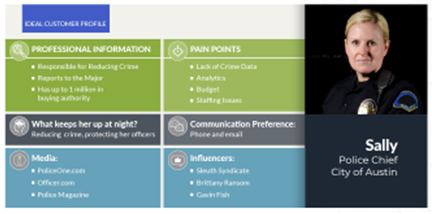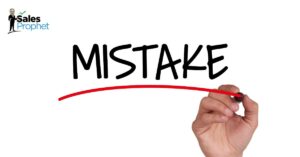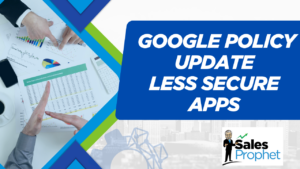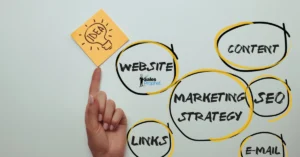Finding your unique niche is the key to opening the door to new prospects and exponential growth.
Finding the right formula when it comes to creating your brand’s Ideal Customer Profile isn’t always as simple.
Luckily, with our proven system and the following steps, you can more accurately and effectively target the quintessential set of customers you need to succeed.
What Is An Ideal Customer Profile & How to Find Yours
Most people would think finding an ideal customer is easy. Pick your largest customer, identify their unique attributes, and bang, there is your ideal customer profile. However, your largest customer might not actually be your ideal ICP.
The image below provides a few options to consider when creating your ideal customer profile.

Surveying your current customers is a cost-effective method of gaining insightful analytics and data that’ll provide a foundation for building your Ideal Customer Profile.
The benefits of finding your ICP include:
Identifying better-fit prospects
Lowering your customer acquisition cost (CAC)
Serving customers better by knowing their pain points and needs
Reducing customer turnover
Considered Purchases with Extended Sales Cycles
B2B marketing is often more complex than B2C marketing because the size of the opportunities is much larger. As a result, these larger opportunities take longer to win or close.
The best way to think of this sales scenario is to understand whether or not you’re selling a “considered product or service” with an extended sales cycle. This means the value of the product or service you are offering is often considered by multiple stakeholders/buyers in the company.
Chances are your direct contact is one of many influencers involved in the buying decision.
So, what does that mean?
Discovering and understanding the unique challenges and needs of each influencer is the key to your sales success.
Often, the decision maker of the company will task a lower-level employee to do the initial research on a particular pain or problem and then report back on key findings to the buying committee. Each member of the buying committee has unique challenges and perspectives that need to be addressed. So, you need to understand each persona involved in this buying process.
We recommend you focus on these personas.
Researcher/Influencer – This persona is simply researching all of the possible solutions for a specific problem and picking the top three or so solutions to compare. The key to attracting the researcher’s attention is to showcase how your product differs from your top competitors that they’re likely researching, too. This helps control the narrative vs. the researcher making their own assumptions.
These personas will also want to know if your company works with similar companies in the same industry and how you are priced.
The End User – This persona is the one who will ultimately end up using your product or service. This means they’ll know the most about its functions and features and will ask specific and direct questions on how it will serve them best. Like, how easy is it to use your product or service? How is it different from what we do today? What does training look like? How long will it take for me to get up to speed? What kind of support should I expect?
Decision-Maker – This persona will want to know if your product or service will fix the problem they are experiencing. How is it better than what we are doing today? Will it make my team more efficient and effective? What kind of ROI can I expect?
Financial Authority – This persona will want to know all of the financial issues, from the terms and conditions, what the service level agreement looks like, what’s the escalation or cancellation policy, etc.
As you can see, each of these personas has different questions and needs that need to be addressed in your sales and marketing efforts.
Asking the Right Questions for Each Unique Persona
Now, once you’ve isolated the specific influencers involved in the buying process, it’s time to dive deeper into each persona.
When you do so, you can identify individualized and specific pain points that’ll help in crafting your messages. Determining these unique personas will require thorough thinking about how the influencer thinks, functions, and operates. To dial in accurate personas, ask yourself the questions below about each group.
Note: these are just sample questions. You might have unique questions based on your product, service or target industry.
What is the influencer’s job title and role?
What are their responsibilities?
What are their biggest challenges?
Who do they work with and report to?
How much purchase authority do they have?
What is their role in the buying decision?
What is their role in the buying process?
What sources of content do they trust? (Peers, online networks, media, associations, online networks etc.)
How do they measure success?
Do they have a relationship with your company today?
If you look at each person involved in the buying process, it is easy to see that if you approach a large opportunity with just one blanket message, you might flop on effectively communicating with each and every one of the personas you’re trying to build credibility.
But, when you take the time to explore each of your Ideal Customer Profiles and fine-tune your messaging to match their questions and concerns, you’re better equipped to generate a lead and or an opportunity.
Warning
Many organizations believe they know their buyers well. They have built personas, and they have detailed product marketing plans. The information you’ve learned today describes how the customer interacts with the product or service. But it fails to document how the customer buys, what content they consume as they conduct research, or what frictions you may need to overcome in your marketing
and sales interactions to better align with the customer’s pre-sale needs.
Of course, in today’s modern B2B world—people are using online research to their advantage prior to sealing the deal more than ever before. In fact, the dark funnel of online content (Reddit, online review websites, professional associations, text messaging, etc.) has forever changed the B2B buying process.
As B2C buying habits and patterns increasingly affect the B2B buying journey—transparency is key!
Because there’s no longer a linear process of tracking and ensuring leads are flowing smoothly through the sales funnel you intended, getting ahead of the curve and protecting that funnel is crucial.
With that in mind, here are some questions to ask to do so successfully:
What’s the most difficult aspect of your job?
What trends and/or regulations are affecting the way you do your job?
What are the trigger events that put you into an active buying process?
Are you proactively looking for the latest and greatest solutions for your business, or are you reactively in the market because of a problem you’ve recently encountered?
What does your research process look like, and where do you typically start?
What information is most helpful as you’re researching new solutions?
Who do you consult with when conducting research?
By using these simple steps to create the perfect ideal customer profile, you’ll reduce wasted time and effort on messaging that just doesn’t land.
Now, go and automate the way you sell using Sales Prophet’s sales and marketing automation platform.




